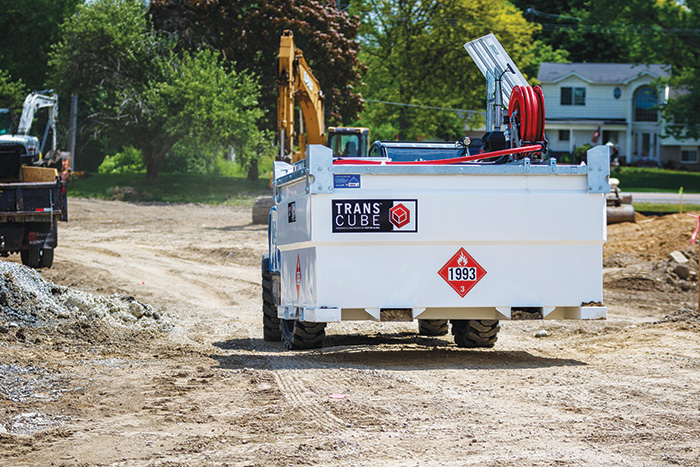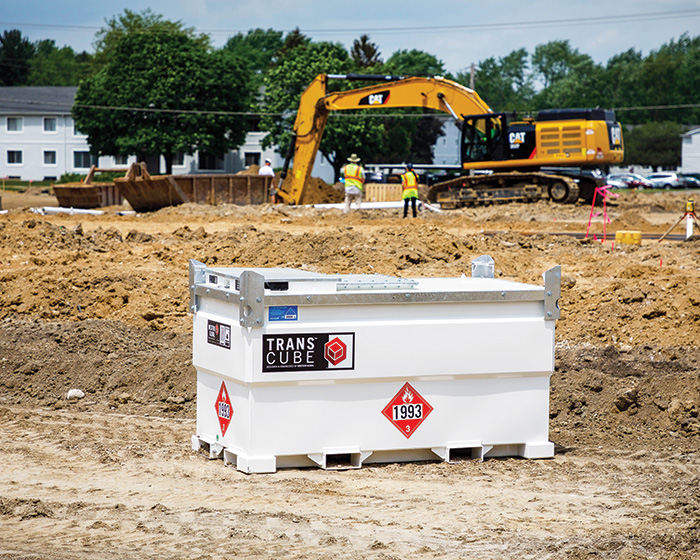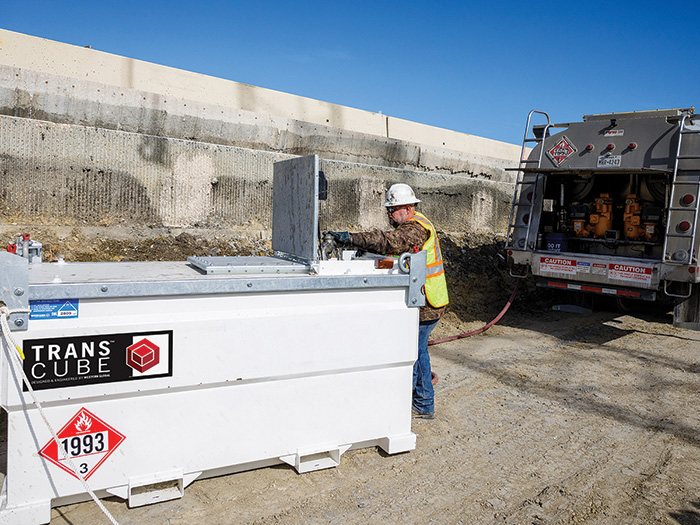Understanding the benefits and industry-leading features of transportable fuel tanks.
By Ken Steury
Responsiveness is critical, especially when it comes to refueling a fleet. With a surge in infrastructure and construction spending coinciding with skyrocketing fuel prices, waste operations may feel their fuel costs are out of control. Transportable fuel tanks can help control these costs and allow contractors to respond to the quickly changing market conditions that impact their bottom line.
Transportable fuel tanks offer not only the cost savings that comes with buying fuel in bulk, but also the ability to reduce fuel consumption. With full-fuel transport capability, these tanks allow the fuel supply to be moved to the equipment that needs to be refueled, reducing the travel distance—and time—to fill tanks and keep equipment operating.From increasing efficiency with a fuel tank that is ready to move immediately, to improving convenience for the crew, here are some benefits and features to understand when considering whether a transportable fuel tank is the right choice for the job.

Photos courtesy of Western Global.
Benefits of a Transportable Fuel Tank
Transportable fuel tanks, approved for transportation when filled with fuel by organizations like the U.S. Department of Transportation and Transport Canada, eliminate the need to drain and clean the tank before moving. This reduces the time to relocate a tank from hours to just minutes, adding efficiency and flexibility to ever-evolving projects. When landfill demands change throughout a project or even over the course of a day, a transportable fuel tank is ready to be moved when and where it is most efficient.
By enabling the fuel supply to travel with the equipment as work progresses, waste operations significantly reduce the distance landfill equipment must travel to refuel. This not only saves time, but also reduces fuel consumption, which translates to more cost savings overall. Transportable fuel tanks are easily moved with equipment that is already at the waste facility, such as forklifts or cranes. Some tanks even offer the ability to be hauled in the back of a truck or mounted on a trailer for quick and easy transportability around the landfill or over the highway, providing on-the-go fuel delivery where it is needed, even in locations with limited access.
Road construction, seeing increased demand in North America, is one area quickly realizing the benefits of transportable fuel tanks. The Infrastructure Investment and Jobs Act in the U.S. has dedicated $110 billion to roads, bridges, and other infrastructure repairs. In Canada, the need for infrastructure maintenance is just as relevant with most of the Trans-Canada Highway—Canada’s longest national road—designed before the 1970s. In these situations, a transportable fuel tank offers the required licensing and approvals for full-fuel transport as the equipment moves along the stretch of highway.
Although it might seem like transportable fuel tanks are the answer only for short-term projects or those with frequent movement, that is not always the case. Transportable fuel tanks can improve fuel efficiency on longer-term projects and can help waste operations save money when it comes time to move the tank. After all, transportable fuel tanks eliminate the need to drain and restock fuel with each move. Plus, the double-walled containment eliminates the need to pay for cleanup of a secondary containment pan. This means operators can efficiently move their fuel tanks without the time and expense that is required to move a traditional fuel tank.
A contractor working on a bridge project in Maryland noticed the benefits of transportable fuel tanks on the jobsite right away. Instead of having to depend on their fuel distributor to move the fuel tank, the crew had the freedom to move their transportable fuel tank whenever they needed. This ease of access to move the tank at any given time improved convenience and efficiency for all involved.
Industry-Leading Design Hallmarks
Not all transportable fuel tanks are created the same. One of the more important items to look for is a sturdy design engineered to withstand the dynamic forces of the moving liquid while navigating soft, uneven refuse mounds at landfills. Tanks designed to comply with required approvals, including UL, ULC, DOT, and Transport Canada, are usually the most rugged and well-designed, as they are required to pass the rigorous testing and certification dictated by the various approval bodies.
Keep in mind that just because a tank is approved for full-fuel transport does not necessarily mean it is the safest option. Some transportable tanks offer a lower center of gravity, for example, that will make the tank less susceptible to tipping during transport. Additionally, tanks with internal baffle plates prevent fuel surging to keep the vehicle stable.
Additional features can help to maximize the ease of transport of these tanks. Designs that integrate multiple attachment points like corner brackets for cranes and four-way forklift pockets allow the transportable fuel tanks to be moved with standard landfill equipment to minimize hassle. A stackable cube shape also improves flexibility for full-fuel transport. This design allows the tanks to take up less space on a truck or in the landfill without sacrificing any of the capacity. Some manufacturers produce tanks that allow for stacking up to two tanks high when full, reducing the footprint when multiple tanks are required at a landfill.

High-Tech Features
One concern some waste operations have with transportable fuel tanks is fuel security. With onsite fuel that is convenient to access, and a tank that is easy to transport, how do you reduce the risk of theft? Next-generation transportable fuel tanks keep ports and pumps inside a secure cabinet. These cabinets contain card-lock dispense controls that only allow authorized individuals to access the fuel. This provides an additional level of security while giving contractors complete control over their fuel. As an added benefit, the technology helps waste facilities keep track of which operators and equipment are using the fuel. This valuable information aids in determining overall efficiency.
Some manufacturers also offer GPS-based remote tank monitoring systems. One of the key features of these systems is the ability to track the tank’s location and inventory levels at any time. These systems also allow equipment operators to keep track of the nearest fuel supply, even when that location changes.

Final Considerations
When looking for a transportable fuel tank, the landfill and project application are the main factors to consider. If the project is short-term or involves a frequent movement, this might be the perfect opportunity to try a transportable fuel tank for cost savings as well as improved flexibility and efficiency. When narrowing down the search for the ideal tank, also check local regulations to see which driver certifications or other approvals are required to transport tanks with fuel on board.
To truly maximize potential, be sure to choose a manufacturer that offers continued support after the sale. With the right combination of equipment and customer service, a transportable fuel tank puts control over fuel costs back into the hands of waste operations. | WA
Ken Steury is Western Global Americas Region Director of Sales. Western Global is a global designer and manufacturer of industry-leading tanks and equipment for fuel storage. Building on a legacy that spans five decades, Western Global offers a wide range of solutions for the safe transportation and storage of fuel. Because every application is unique in its operational storage needs, Western Global engineers industry-specific solutions to ensure success in all of your business endeavors. For more information, visit www.western-global.com or connect on LinkedIn at www.linkedin.com/company/westernglobal.
